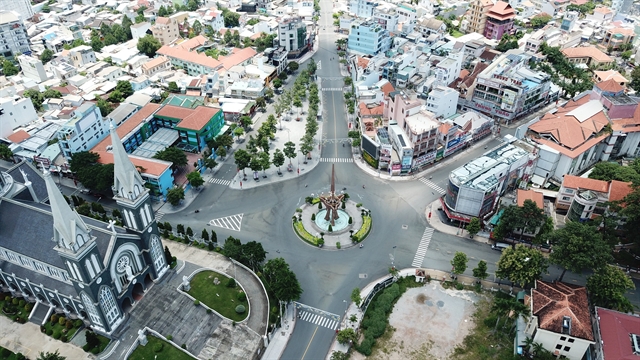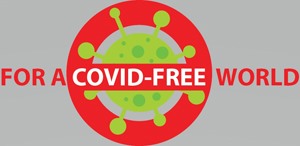 Society
Society

Việt Nam is experiencing the heaviest outbreak ever: the number of cases has reached more than 300,000 and the death toll has been more than 7000.

|
| Bình Dương Province will extend social distancing until the end of August as the number of daily new infections in the province is on the rise. Experts say it is better to lock down or apply social distancing early, bringing the number of infections to zero, and then reopen society later. VNS Photo Trương Vị |
Thu Vân
This week started with the news that HCMC will extend its social distancing status by another month until September 15.
This is due to the fact that the COVID-19 pandemic is still raging in HCMC with the number of daily new infections on the rise. The fatality rate in the city remains high at 241 deaths on average per day.
Despite an ongoing social distancing order, most districts in the city have seen the number of COVID-19 community transmissions dramatically increase in the past week.
Việt Nam is experiencing the heaviest outbreak ever: the number of cases has reached more than 300,000 and the death toll has been more than 7,000.
The pandemic quickly spread to 62 out of 63 provinces and cities across the country.
Until May this year, Việt Nam's COVID-19 prevention strategy was still said to be among the most effective in the world. But now, with the new strain of the virus, despite its best efforts to control the pandemic, the number of cases in the country is still between 8,000 and 10,000 a day.
The Delta strain of the virus has had the worst impact on Việt Nam. Although the authorities are applying the same methods as in the past, the results are not the same. Addressing a government meeting on Wednesday, Prime Minister Phạm Minh Chính said the fight against the pandemic so far "has not achieved the results expected" though authorities, the public and businesses "have tried hard and made a lot of efforts."
So is it time for a new approach?
Trần Đắc Phu, senior advisor to the Việt Nam Public Health Emergency Operations Centre, believes so.
The number of cases increased very quickly and detected in many places such as: industrial parks, markets, hospitals, apartment communities, supply chains, so it spread more quickly, everywhere in the whole country.
Because of the rapid spread in a short space of time, the number of F0s and F1s increased, leading to an overload in the healthcare system and concentrated isolation areas.
This requires a change in strategy to deal with the pandemic.
First, quick tracing can still be applied in “green areas”, but for "red zones" like HCM City, the authorities have instead focused on treatment. At the same time, the city has shifted to isolating F1 patients at home, and supporting COVID-19 patients who are asymptomatic to be treated at home. "The important goal now is to reduce the number of deaths," Phu said.
Second, testing is not merely to trace contacts of COVID-19 patients anymore. Depending on certain areas, testing might be used to trace infections, or for risks assessment, or evaluation of the effectiveness of social distancing.
Nguyễn Thu Anh, an epidemiologist and country director of the Woolcock Institute of Medical Research, shared the same opinion.
She said Việt Nam's testing capacity and speed has increased remarkably. When the pandemic broke out in Bắc Ninh and Bắc Giang provinces in May, the testing capacity of the whole country was about tens of thousands of samples per day, but now that number has increased tenfold.
The prevailing strategy of Việt Nam until the end of July in the southern provinces, which are most affected by the fourth wave, is to “test as many people as possible for contact tracing and quarantine as quickly as possible” .
But "testing, contact tracing and isolation” had not been able to keep up with the speed the virus had spread, she said.
Ben Marais, an infectious diseases physician and Deputy-Director of the Marie Bashir Institute, University of Sydney, said Australia’s strategy was also test, test and test, but it only works when the number of cases is small.
When the spread of the infections becomes unpredictable, the solution is to apply social distancing or lockdown in certain areas or communities, according to the physician. Testing at that time is to serve the purpose of correctly evaluating the effectiveness of social distancing or lockdown policies, and when to loosen or remove such measures.
Social distancing to buy time for vaccination
Currently, Việt Nam is implementing social distancing at the highest level (Prime Minister’s Directive 16) in more than 20 provinces and cities across the country.
From the experience of Australia, Prof. Marais said that the country used to pursue a policy of "containment" of COVID-19, meaning that it would tolerate infections in the community to a certain extent, so as not to have a great impact on the economy. But after the past 18 months and especially before the spread of the Delta mutation, the country had realised that this policy was not optimal in terms of cost.
"It is better to lockdown or apply social distancing early, bringing the number of infections to zero, and then reopen society later."
That's also the reason why although the number of infections now in Australia is much smaller than in previous outbreaks, only hundreds of cases per day, but now most Australian residents are living in lockdown.
Prof. Marais said, with the current situation, at least the state of New South Wales, would maintain lockdown until the number of infections reduces to 5-10 cases a day and these few cases are only in the quarantined areas.
According to James Trauer, a health data analyst and health economist from Monash University in Australia, when his team modelled disease data for the Philippines and Malaysia, they found that if vaccination is conducted without implementing lockdown and social distancing, the number of cases will skyrocket to tens of thousands per day in the mid-August period.
Prof. Marais believes that the longer you apply social distancing, the more careful you need to be when removing it, otherwise, the gains made will be meaningless.
Deputy Minister of Health Trần Văn Thuấn said that in August and September, Việt Nam expects to receive 20 million doses of COVID-19 vaccines and more will be delivered in the fourth quarter of the year. The health ministry expects that by early 2022, 75 per cent of the population will have been vaccinated.
No one left behind
While buying time, the Government and localities are doing their best to support people and ensure no one lacks food or shelter.
The Government has decided to use the national food reserve and will consider using the trade union fund to provide relief assistance to poor people in COVID-19-hit areas. It also decided to provide another 130,000 tonnes of rice from the national reserves to feed 8.6 million people facing hunger in 24 cities and provinces, mostly in southern Việt Nam.
HCMC itself had asked the Government for a relief package of VNĐ28 trillion ($1.22 billion) and 142,200 tonnes of rice to help more than 4.7 million people.
The money is expected to cover food and rent expenses to help poor working families, especially migrants, and prevent them from trying to leave the city in droves as seen in recent days.
According to the Việt Nam General Confederation of Labour, the ongoing pandemic has affected more than 1.3 million workers who have lost their jobs, had their contracts suspended or stopped working. About 30,000 workers have been infected with the virus in 50 cities and provinces; 330,000 are related to the infected workers; and 390,000 workers are living in lockdown areas. VNS

|




